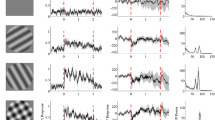Summary
The effect of monocular and binocular stimulation on cortical neurons of area 17 was investigated in awake unparalyzed cats with painless head fixation. Two types of stimuli were applied: Stationary gratings of variable orientations, and a 3° wide dark stripe at different orientation and moving in different directions. All neurons which were excited from both eyes showed qualitatively similar input properties (orientation specificity, movement and/or direction sensitivity). Quantitatively, the input from both eyes was either equal or dominant from one eye. Contralateral dominance was found 5 times more frequently than ipsilateral dominance. Various types of binocular interaction were found. Some neurons showed an excitatory response from one eye and inhibitory response from the other (inhibition, 14% of our units), and others showed a response during binocular stimulation which was equal to the sum of the monocular responses (summation, 18%), larger (facilitation, 43%) or smaller (occlusion, 14%) than the sum of the two monocular responses. A few units with binocular responses did not respond to monocular stimulation of one or both eyes. The results are compared with those found by other authors in paralyzed and anesthetized animals, and current theories of neuronal mechanisms of binocular vision are discussed in the context of our findings.
Similar content being viewed by others
References
Barlow, H.B., Blakemore, C., Pettigrew, J.D.: The neural mechanism of binocular depth discrimination. J. Physiol. (Lond.) 193, 327–342 (1967).
Bishop, P.O.: Neurophysiology of binocular single vision and stereopsis. Handbook of sensory physiology, VII/3.
Blakemore, C.: The representation of three-dimensional visual space in the cat's striate cortex. J. Physiol. (Lond.) 209, 155–178 (1970).
—, Pettigrew, J.D.: Eye dominance in the visual cortex. Nature (Lond.) 225, 426–429 (1970).
Burns, B.D., Pritchard, R.: Cortical conditions for fused binocular vision. J. Physiol. (Lond.) 197, 149–171 (1968).
Creutzfeldt, O.D., Pöppel, E., Singer, W.: Quantitativer Ansatz zur Analyse der funktionellen Organisation des visuellen Cortex (Untersuchungen an Primaten). O.J. Grüsser (Ed.): Kybernetik 1970. Springer Berlin-Heidelberg-New York 1971.
Henry, G.H., Bishop, P.O., Coombs, J.S.: Inhibitory and subliminal excitatory receptive fields of simplecells in cat striate cortex. Vision Res. 9, 1289–1296 (1969).
Hubel, D.H., Wiesel, T.N.: Receptive fields, binocular interaction and functional architecture in the cat's visual cortex. J. Physiol. (Lond.) 160 106–154 (1962).
—: Receptive fields and functional architecture in two nonstriate visual areas (18 and 19) of the cat. J. Neurophysiol. 28, 229–289 (1965).
—: Receptive fields and functional architecture of monkey striate cortex. J. Physiol. (Lond.) 195, 215–244 (1968).
—: Anatomical demonstration of columns in the monkey striate cortex. Nature (Lond.) 221, 747–750 (1969).
Nikara, T., Bishop, P.O., Pettigrew, J.D.: Analysis of retinal correspondence by studying receptive fields of binocular single units in cat striate cortex. Exp. Brain Res. 6, 353–372 (1968).
Noda, H., Manohar, S., Adey, W.R.: Spontaneous activity of cat hippocampal neurons in sleep and wakefulness. Exp. Neurol. 24, 217–231 (1969).
— Freeman, R.B., jr., Gies, B., Creutzfeldt, O.D.: Neuronal responses to stationary and moving targets in the visual cortex of awake cats. Exp. Brain Res. 12, 389–405 (1971a).
- -: Neuronal correlates of eye movements in the cat visual cortex. Science (1971b).
Pettigrew, J.D., Nikara, T., Bishop, P.O.: Binocular interaction on single units in cat striate cortex: Simultaneous stimulation by single moving slit with receptive fields in correspondence. Exp. Brain Res. 6, 391–410 (1968).
Rodieck, R.W., Stone, J.: Response of cat retinal ganglion cells to moving visual patterns. J. Neurophysiol. 28, 819–832 (1965).
Author information
Authors and Affiliations
Additional information
This work was supported by the Deutsche Forschungsgemeinschaft as a research project in the „Sonderforschungsbereich Kybernetik” (SFB 31).
Dr. R.B. Freeman, jr. was supported by NIH-grant 363-93600-21, MF-428-69 during the period of this research.
Rights and permissions
About this article
Cite this article
Noda, H., Creutzfeldt, O.D. & Freeman, R.B. Binocular interaction in the visual cortex of awake cats. Exp Brain Res 12, 406–421 (1971). https://doi.org/10.1007/BF00234495
Received:
Issue Date:
DOI: https://doi.org/10.1007/BF00234495




